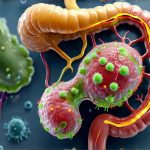The human microbiome—the vast community of bacteria, fungi, viruses, and other microorganisms residing within us—is increasingly recognized as fundamental to overall health. It’s not simply about digestion; this intricate ecosystem impacts everything from immune function and mental wellbeing to nutrient absorption and even disease risk. Modern lifestyles, however, often subject our microbiomes to significant stress: antibiotic use, processed foods, chronic stress, and, notably, restrictive diets or intensive cleanse protocols can all disrupt the delicate balance of microbial life within us. While these interventions may be pursued with good intentions – detoxification, weight loss, elimination of sensitivities – they frequently come at a cost, often reducing microbial diversity. This reduction isn’t merely an aesthetic concern; it’s linked to diminished resilience and potentially increased susceptibility to various health challenges.
The challenge then becomes: how do we rebuild this lost diversity? It’s not about simply adding probiotics (though those can play a role); it’s about creating an environment where beneficial microbes can flourish, repopulating the gut with a wide range of species. This requires a holistic approach that considers diet, lifestyle factors, and potentially targeted interventions to support microbial restoration. Understanding the mechanisms through which cleanses or extreme diets disrupt the microbiome is crucial for designing effective rebuilding strategies. It’s also important to remember that everyone’s microbiome is unique, meaning there’s no one-size-fits-all solution. The goal is to cultivate a thriving internal ecosystem tailored to your individual needs and circumstances. If you are struggling after an event, consider building a recovery plan to help guide your journey.
Understanding Microbiome Disruption & Depletion
Intense cleanse protocols – juice cleanses, detox diets, elimination diets focusing on very limited food groups – often severely restrict dietary fiber intake. Fiber isn’t digested by our bodies; instead, it serves as the primary food source for beneficial gut bacteria. When fiber is scarce, these microbes starve, leading to a decrease in their populations and a subsequent reduction in diversity. Similarly, extreme diets like ketogenic or carnivore diets, while potentially effective for certain individuals, can drastically limit the range of nutrients available to different microbial species, favoring those that thrive on specific substrates (like fats) and suppressing others. This creates an imbalanced ecosystem. Antibiotics, frequently used alongside or following these protocols to address die-off symptoms, exacerbate the problem by directly killing both harmful and beneficial bacteria.
Beyond dietary restrictions, the rapid changes induced by cleanses can disrupt gut motility – the movement of food through the digestive tract. Altered motility impacts microbial distribution and colonization patterns. Furthermore, some cleanse ingredients (like certain laxatives or enemas) can physically flush out gut contents, removing both waste and beneficial microbes. The resulting environment becomes less hospitable to a diverse microbiome, hindering its natural ability to recover. It’s vital to acknowledge that the “detoxification” often touted by these protocols is largely performed by the liver and kidneys; aggressively altering gut flora doesn’t necessarily enhance this process and can instead create more problems than it solves. Restoring digestive balance is key to getting back on track.
The consequences of reduced microbial diversity extend far beyond digestive issues. A less diverse microbiome is associated with: – Impaired immune function, making you more vulnerable to infections. – Increased inflammation throughout the body. – Reduced nutrient absorption. – Altered mental health, due to the gut-brain axis connection. – Potential for increased sensitivity to food intolerances and allergies. Essentially, a depleted microbiome weakens your body’s natural defenses and compromises its ability to function optimally. Recognizing this disruption is the first step towards rebuilding. Rebuilding trust with food can be a difficult, but important process.
Strategies For Rebuilding Microbial Diversity
Rebuilding microbial diversity isn’t about quick fixes; it’s a gradual process that requires patience and consistency. The cornerstone of any successful strategy is dietary modification. Focus on incorporating a wide variety of plant-based foods, rich in different types of fiber. This includes: – Fruits (berries, apples, bananas) – Vegetables (leafy greens, cruciferous vegetables, root vegetables) – Legumes (beans, lentils, chickpeas) – Whole grains (oats, quinoa, brown rice) Each food type feeds different microbial species, promoting a more diverse ecosystem. Prioritize prebiotic-rich foods – those containing compounds that selectively nourish beneficial bacteria. Examples include garlic, onions, leeks, asparagus, and Jerusalem artichokes.
Beyond simply what you eat, consider how you eat. Chewing your food thoroughly aids digestion and allows microbes to access nutrients more efficiently. Eating slowly and mindfully reduces stress, which can negatively impact gut health. Fermented foods – yogurt (with live cultures), kefir, sauerkraut, kimchi, kombucha – introduce beneficial bacteria directly into the gut. However, it’s important to start with small amounts to avoid digestive upset and choose products that haven’t been pasteurized, as pasteurization kills the live cultures. It is also essential to manage stress levels through techniques like meditation, yoga, or spending time in nature. Chronic stress negatively impacts the microbiome and hinders its ability to recover. Reintroducing foods slowly is crucial after a disruption.
The Role of Probiotics & Postbiotics
Probiotics – live microorganisms intended to benefit the host – can be a helpful adjunct to dietary changes, but they are not a replacement for them. The key is selecting probiotics strategically. Don’t just choose a random probiotic with billions of CFUs (colony forming units). Look for strains that have been specifically researched and shown to address your individual needs. Consider consulting with a healthcare professional or registered dietitian who specializes in gut health to determine the most appropriate probiotic for you. It’s also important to understand that probiotics are transient; they don’t permanently colonize the gut. Their benefit comes from their temporary interaction with the existing microbiome, stimulating its activity and potentially crowding out harmful bacteria.
Postbiotics – the metabolic byproducts produced by beneficial bacteria during fermentation – are gaining recognition as a powerful way to support gut health. These compounds (like short-chain fatty acids, vitamins, and enzymes) have numerous benefits for the host, including reducing inflammation, strengthening the gut barrier, and improving nutrient absorption. Postbiotic supplements are available, but you can also increase postbiotic production naturally by feeding your gut bacteria with prebiotic-rich foods. Essentially, prebiotics feed probiotics, which then produce postbiotics – creating a synergistic cycle of gut health support. Managing acid buildup can also contribute to improved digestion.
Long-Term Gut Health Maintenance
Rebuilding microbial diversity is an ongoing process, not a destination. To maintain a healthy microbiome long-term: – Prioritize a diverse, plant-rich diet consistently. – Manage stress levels effectively. – Limit antibiotic use to only when absolutely necessary (and always under medical supervision). – Avoid excessive alcohol consumption and smoking. – Get adequate sleep – sleep deprivation disrupts gut health. – Consider periodic testing of your microbiome to monitor its composition and identify areas for improvement. This can provide personalized insights into your gut health status and guide your dietary and lifestyle choices. Rebuilding gut resilience will help you better withstand future disruptions.
Focus on building a resilient ecosystem. A diverse and balanced microbiome is better equipped to withstand challenges, such as illness or stress, without collapsing. Remember that the goal isn’t necessarily to achieve a “perfect” microbiome; it’s to cultivate a thriving community of microbes that supports your overall health and wellbeing. By adopting these strategies and prioritizing gut health, you can significantly improve your resilience and optimize your long-term health outcomes. It’s about fostering a symbiotic relationship with the trillions of microorganisms within us – recognizing them not as invaders but as essential partners in our journey to optimal wellness.


















